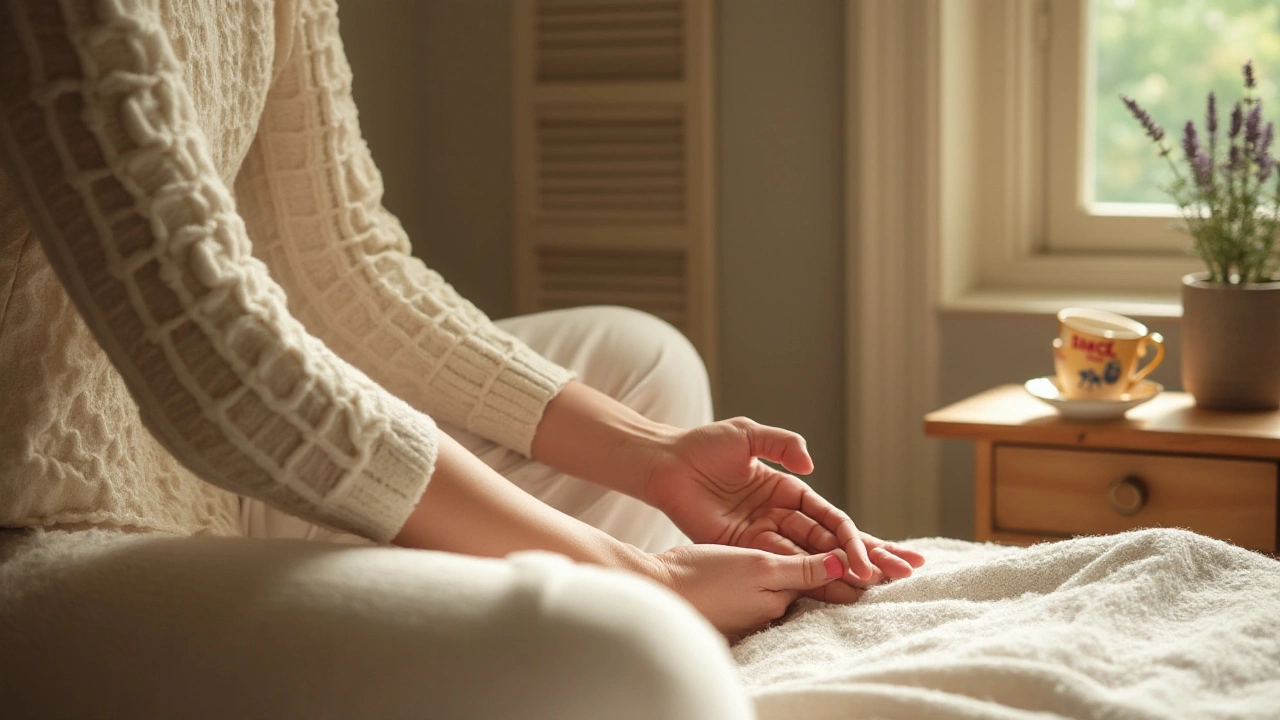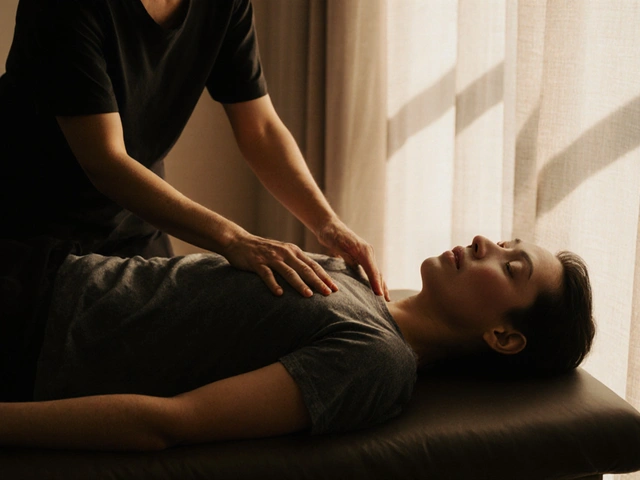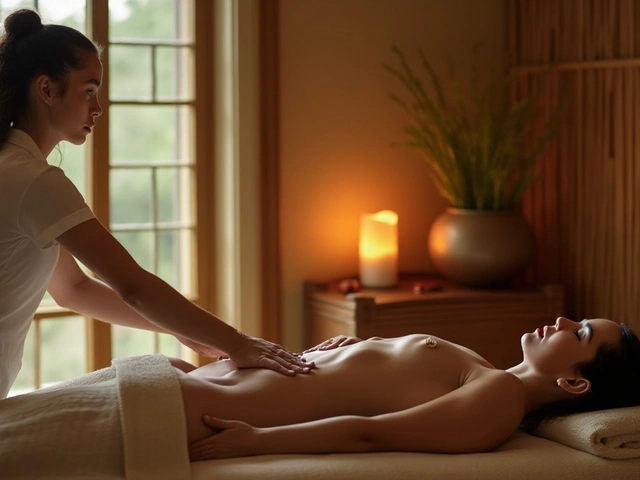Discovering Acupressure Techniques to Combat Insomnia Effectively

Many people toss and turn at night, struggling to drift into the deep, rejuvenating sleep they need. Insomnia can be frustrating, but there's a traditional method that may provide relief without reaching for pills: acupressure. This ancient practice taps into specific pressure points on the body to help ease tension and promote a restful night's sleep.
For centuries, have relied on acupressure to balance energy and improve overall health. Its focus on the body's healing points makes it a fascinating alternative for those dealing with sleep issues. By understanding how to apply gentle pressure to strategic points, it is possible to relax the body and mind, paving the way for better sleep.
- Understanding Acupressure
- The Connection Between Acupressure and Sleep
- Key Pressure Points for Enhancing Sleep
- Simple Techniques for Daily Practice
- Combining Acupressure with Lifestyle Changes
- Potential Benefits and Precautions
Understanding Acupressure
Acupressure is an age-old practice rooted in the traditions of Chinese medicine, where it is believed that the body contains a flow of vital energy known as 'Qi' or 'Chi'. This energy travels through pathways called meridians. When these meridians are blocked or unbalanced, it can lead to various physical and emotional ailments, including insomnia. By applying pressure to specific points along these meridians, acupressure aims to restore balance and open up these energy channels, potentially alleviating issues like sleeplessness.
The beauty of acupressure lies in its simplicity and accessibility. Unlike acupuncture, which requires needles and often a professional hand, acupressure can be learned and applied by anyone. The use of fingers to apply pressure allows individuals to manage their own stress and sleep issues from the comfort of their home. No special tools are needed; just basic knowledge of where and how to apply pressure can work wonders in easing stress and promoting rest.
Various points on the body are specifically linked to sleep and relaxation. For instance, the 'Anmian' point, located just behind the earlobe, is well-regarded for its sleep-inducing benefits. Gently massaging this spot can soothe the mind and encourage restful slumber. Another prominent point is the 'Shen Men', or Heart 7, on the wrist, which is often associated with calming the nerves and aiding in bedtime relaxation.
"Acupressure is a wonderful option for those looking to enhance their sleep without the use of medication," says Dr. Laura Avila, a traditional Chinese medicine practitioner. "By consistently applying pressure to specific points, individuals can experience profound changes in their sleep quality."
While acupressure is widely recognized as a safe practice, it's essential to apply the correct amount of pressure — neither too light nor too harsh. Too much push may lead to discomfort, not relaxation. By listening to one's body and adjusting as needed, the right balance can lead to beneficial results. It's also worth noting that while many find relief through these techniques, results can vary due to individual differences. Therefore, patience and consistency are key when exploring acupressure for sleep issues.
This practice isn't just about stress points; it often involves the whole body. Incorporating slow and deep breathing while applying pressure can enhance relaxation. Techniques can be performed anywhere from the comfort of your bed to even during a brief pause in a hectic day, offering minute spasms of tranquility. With practice, acupressure can become an empowering tool in one’s arsenal against insomnia — a gentle, natural remedy facilitating restorative sleep and nurturing the body's innate ability to heal itself.
The Connection Between Acupressure and Sleep
It’s fascinating how acupressure, an ancient healing art rooted in traditional Chinese medicine, relates to something as universal as sleep. This practice operates under the belief that the body is a complex, interconnected web of energy pathways, known as meridians. Within these meridians lie specific pressure points that, when stimulated, can harmonize energy flow and promote relaxation, making it a natural ally against insomnia. The idea is that by applying gentle but firm pressure to these points, one can ease the mind and body into a state conducive to restful sleep.
One of the reasons acupressure is so effective for promoting sleep is its ability to activate the parasympathetic nervous system. This part of the nervous system is often dubbed the ‘rest and digest’ system because it’s responsible for slowing down the heartbeat, relaxing muscles, and overall calming the body. When acupressure is applied, it can trigger this response, helping those wrestling with high levels of stress or anxiety that typically hinder sleep. It’s not just about falling asleep more quickly but about improving the quality of sleep, reducing nighttime awakenings and enhancing overall sleep satisfaction.
A notable pressure point often associated with sleep improvement is the Spirit Gate. Located on the crease of the outer wrist, this point's stimulation is thought to soothe the mind and contribute to a peaceful slumber. Other points like the Three Yin Intersection and the Bubbling Spring are also commonly targeted to alleviate health issues that could disrupt sleep, such as indigestion or tension headaches. By holistically addressing these areas, acupressure presents itself as a comprehensive approach to better sleep.
Interestingly, studies have backed some of these claims. Research published in the Journal of Sleep Research suggests that acupressure can significantly reduce sleep disturbances for certain individuals. Patients reported not only falling asleep faster but experiencing a deeper, more constant sleep cycle. These findings have sparked curiosity among medical professionals exploring non-pharmaceutical interventions for sleep disorders. As Dr. Michael Breus, a noted sleep specialist mentioned,
“Acupressure offers a practical, non-invasive way to tackle insomnia, appealing to those wary of conventional medicine.”
The rise in popularity of acupressure for insomnia is a testament to our growing desire for sustainable and natural health solutions. People now appreciate the way these traditional methods conveniently fit into busy lifestyles, offering benefits without a lengthy commitment or financial burden. With simple practices, one can enact profound changes in their sleep routine. The next step is learning the specifics of each pressure point and integrating these techniques into daily life.
For many, practicing acupressure has become a sacred bedtime ritual. It’s a few moments of quiet self-care, helping the body unwind and transition smoothly into rest. This process highlights both the power and simplicity of human touch, making it a poignant illustration of our inherent ability to heal and rejuvenate.

Key Pressure Points for Enhancing Sleep
When aiming for a peaceful night, knowing which pressure points to focus on can be invaluable. Perhaps one of the most renowned is the 'Shen Men,' also referred to as the ‘Spirit Gate.’ Found on the heart meridian, it rests on the inner wrist, aligned with the small finger. Gently massaging this spot can invite calmness and decrease anxiety, often contributing to better, more restful sleep. Another well-regarded point is the 'Anmian,' located behind the ear. True to its name, which means ‘Peaceful Sleep,’ consistent pressure here can soothe the mind and reduce insomnia symptoms. These points, amidst others, act as gateways to your body's natural rhythms.
The 'Bubbling Spring' or 'Kidney 1' point found on the sole of the foot is another essential area many turn to. This spot starts off the body's entire energy cycle, and activating it has been said to ground your energy which can be remarkably effective in promoting tranquility. Consider incorporating gentle, circular pressure on this point before settling down for the night. A more surprising spot might be the 'Tai Chong' or 'Liver 3' point located on the top of the foot, nestled between the big toe and the second toe. Known to balance the liver’s energy, this point when engaged correctly can lead to smoother mood regulation, paving the way for a sound night’s sleep.
Meanwhile, the 'Yin Tang' point, nestled right between the eyebrows, is a favorite among many acupressure enthusiasts. Accessible and uncomplicated to find, it has a reputation for reducing stress and promoting relaxation, creating an ideal stage for sleep. In a quote from renowned practitioner Susan Craig, 'Working with these energy centers seamlessly integrates mind and body, paving an easy pathway to a rejuvenated morning.'
She explains, 'When you couple these techniques with habit changes, the rituals of rest become naturally embedded in one's day-to-day life.'Implementing acupressure techniques can be straightforward and engaging, ultimately making it an admired choice for those encountering sleep disturbances.
One should consider pairing these practices with slow, deep breathing to further enhance their impact. It's not solely about pressing a point; the mind-body connection plays a critical role. Upon mastering acupressure, the delicate balance between technique and intention often leads to improved sleep patterns. And there, in the silence of the night, after harnessing these points, the transition to rest becomes something attainable. Integration of these techniques into your nightly routine doesn't demand a massive time investment but promises profound potential for improvement. As you journey into the world of acupressure, let each connection to your pressure points serve as a reminder that sleep can be achieved naturally and harmoniously.
| Pressure Point | Location | Benefit |
|---|---|---|
| Shen Men | Inner Wrist | Reduces Anxiety |
| Anmian | Behind the Ear | Promotes Peaceful Sleep |
| Bubbling Spring | Sole of the Foot | Grounds Energy |
| Tai Chong | Top of the Foot | Balances Mood |
| Yin Tang | Between Eyebrows | Reduces Stress |
Simple Techniques for Daily Practice
Getting started with acupressure doesn't require a lot of fancy equipment or extensive training. In fact, most techniques can be performed in the comfort of your home using just your hands. This hands-on approach not only makes it accessible but also integrates smoothly into any routine. A few minutes of practice each day can make a significant difference in improving your sleep quality.
To begin, locate the insomnia relief point known as the Pericardium 6 (P6). It is found about three finger widths below the wrist on the inner forearm, between the two tendons. Applying gentle pressure on this point can help calm the mind and ease stress, making it one of the most used points in acupressure to combat sleep issues. Spend about 2-3 minutes applying firm yet comfortable pressure on this spot in a circular motion, ideally before you go to bed.
Another good practice is stimulating the Anmian, which is located near the depression behind the ear. This point's name translates to "peaceful sleep," and gently massaging it for a few minutes at bedtime can help release night-time anxiety. You can further enhance the effect by incorporating deep breathing exercises during your session, helping to center your mind and prepare your body to rest.
Acupressure is ideally coupled with lifestyle changes such as reducing screen time before bed and maintaining a consistent sleep schedule, all of which synergistically enhance the benefits. According to a study published in the "Journal of Sleep Research," around 65% of participants reported improved sleep patterns after practicing acupressure for just one month. This speaks volumes about the effectiveness of these ancient techniques when performed regularly.
"As we align our breath and touch through acupressure, we invite tranquility and restore balance amid a fast-paced world," notes Dr. Aaron Michelfelder, a family medicine physician with deep insights into integrative medicine.
Consistency is the key; try to incorporate these practices throughout your day, especially during moments of rest or meditation. The beauty of these practices is their portability and simplicity, allowing you to foster wellness through natural remedies. With diligence and patience, acupressure can become a powerful ally in your fight against insomnia.

Combining Acupressure with Lifestyle Changes
While acupressure can significantly aid in combating insomnia, its benefits can be even more pronounced when combined with positive lifestyle changes. By integrating acupressure with a holistic approach to health, individuals are more likely to see an improvement in their sleep patterns. It involves looking at sleep through multiple lenses, addressing not just the physical, but also the mental and emotional components.
It's important to establish a consistent sleep routine that aligns with the body's natural circadian rhythms. Going to bed and waking up at the same time every day can help regulate your inner clock, making it easier to fall asleep. In contrast, irregular schedules can confuse the body, making acupressure less effective. By prioritizing consistent sleep patterns, you provide a solid foundation for acupressure techniques to flourish. Additionally, creating a calming bedtime environment can enhance the value of sleep aids like acupressure. Consider minimizing electronic distractions and opting for activities that promote relaxation, such as reading or journaling, which help ease the transition from wakefulness to sleep.
Diet and physical health also play crucial roles. Say goodbye to late-night caffeine or heavy meals that can disrupt sleep. Instead, focus on balanced nutrition that supports rest, such as foods rich in magnesium and calcium, known to relax muscles and calm the mind. Exercise, too, should be part of this regimen, as it helps alleviate stress and promote tiredness, making the body's receptiveness to acupressure more pronounced.
Stress management is another critical area. The tension we carry throughout the day often ends up in our sleep. Acupressure, paired with mindfulness practices like meditation or yoga, can serve as a powerful stress-reducing combination. The key is to practice regularly, creating a synergy between physical relief from acupressure and mental clarity from mindfulness.
"The combination of acupressure and lifestyle shifts has shown promising results in managing insomnia among various populations," notes Dr. Felicity Cornell from the Sleep Institute.
An often overlooked aspect is the importance of hydrating and ventilation. Proper hydration can maintain body balance, while fresh air circulation aids in cooling the body, necessary for deep sleep. These simple changes, when coupled with targeted acupressure practices, create a conducive environment for a restful slumber.
Potential Benefits and Precautions
Exploring the world of acupressure can open doors to a new way of managing your sleep concerns like insomnia. One significant benefit of this natural remedy is its accessibility; no fancy equipment or professional intervention is required for basic techniques to get started. This empowers individuals to have more control over their sleep patterns and lifestyle. It can be practiced anywhere—from the comfort of your bed to a quiet spot in your living room—which adds an element of convenience to its appeal.
Acupressure has been known to promote relaxation and ease away stress, two critical elements needed for a restful night's sleep. By targeting specific pressure points, such as the An Mian point behind the ear and the Shen Men point on the wrist, the body can be coaxed into a state of calmness. These pressure points are known for their effectiveness in mitigating conditions like anxiety and racing thoughts, which are common culprits in sleepless nights. A study published in the Journal of Alternative and Complementary Medicine found a significant improvement in sleep quality amongst participants who practiced **acupressure** regularly.
However, it's crucial to approach acupressure with a mindset of precaution as well. For those new to acupressure, starting with gentle pressure is safe practice to avoid overwhelming sensitive areas of the body. People with specific medical conditions, such as arthritis or osteoporosis, should consult healthcare professionals before engaging deeply in any new manual therapies. Additionally, pregnant individuals should be cautious as certain points might induce muscle contractions or affect hormonal balances.
It's also pertinent to recognize that while acupressure can be beneficial in managing insomnia, it isn't a one-size-fits-all solution. Combining acupressure with other lifestyle changes, such as maintaining a regular bedtime or reducing screen time before bed, can amplify its effectiveness. Dr. Michael Breus, known as 'The Sleep Doctor,' emphasizes the importance of avoiding caffeine before bed, logging sleeping hours to notice patterns, and ensuring your bedroom environment promotes peace.
An awareness of your body's reactions is essential too—as with many alternative therapies, responses can differ widely among individuals. To ensure you reap the full benefits without unintended effects, consider maintaining a journal to record changes in sleep quality correlating with your acupressure practice. Being observant not only helps pinpoint the most effective pressure points but also contributes to creating a custom sleep-enhancing routine.
"Acupressure is a powerful tool, but like all powerful tools, it should be used with knowledge and care," says Dr. John Baraglia, a leading practitioner in the field of alternative medicine.
For those dedicated to integrating this practice, patience, and persistence often pay off. Many find that their initial efforts in acupressure, when combined with other sleep hygiene practices, allow for a gradual and more profound transformation in their sleeping habits. When leveraged correctly, this centuries-old technique holds the potential to harmonize the body's natural rhythms and improve not only one's sleep but also their overall well-being.





